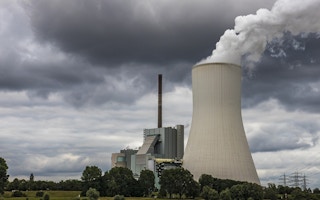US President-elect Joe Biden’s inauguration comes just a month after the fifth anniversary of the Paris climate agreement, auguring long-overdue progress in the global fight against climate change.
Despite recent political commitments by major emitters to achieve carbon neutrality by mid-century, the world still is not yet on track to prevent global warming from exceeding 2° Celsius—a target that must be reached to avert massive disruptions to human societies.
Fortunately, we can at least quantify the challenge at hand. According to the International Energy Agency, global energy-related carbon-dioxide emissions in 2019 totalled roughly 33 billion tonnes—a figure that ultimately must be reduced to net zero.
“
One of the Paris agreement’s primary weaknesses, in addition to its “nationally determined contributions” being non-binding, is that it addresses the volume of emissions, giving hardly any role to the price of carbon.
Carbon capture and storage (CCS) can remove carbon from the air, but it varies significantly in cost. Assuming this technology be deployed at scale at an average cost of $100 per ton, we can calculate that removing the CO2 emitted in 2019 would cost $3.3 trillion.
And considering, not unreasonably, that the cost of abatement ($100 per tonne) coincides with the social cost incurred by global warming, we can then compare this figure to the wealth created by an economy like Germany, where 2019 GDP amounted to $3.861 trillion. That yields the formidable price that must be paid annually to prevent any further aggravation of climate change.
To economists, the obvious solution is to follow the “polluter pays” principle. Each country should tax or set a price of $100 per tonne of CO2 emitted on its territory, the proceeds of which should go toward purchasing the carbon that has been removed by firms engaged in CCS.
The problem with this option is that it lacks even the slightest chance of being adopted anytime soon. Many constituencies would object that this approach places a disproportionately large cost on the most economically vulnerable people. But let us bear in mind that these people suffer the most from climate change.
The more immediate task should be to mobilise funds needed to deploy CCS on a global scale. One of the Paris agreement’s primary weaknesses, in addition to its “nationally determined contributions” being non-binding, is that it addresses the volume of emissions, giving hardly any role to the price of carbon.
With a more explicit, universally applied carbon price, we could simultaneously discourage emissions, encourage innovation and investment in decarbonisation technologies such as CCS, and start using it to suck carbon out of the air.
Now consider the European Union, which has pledged to achieve carbon neutrality by 2050 and a 55 per cent reduction by 2030. Many member states have already adopted legally binding targets (including Denmark, France, Germany, Hungary, and Sweden).
To move things along, the EU can use the emissions market that it created 15 years ago. This powerful device already covers 45 per cent of the bloc’s emissions, but it could be improved.
Because Europe’s carbon market initially targeted only the volume of carbon emissions – relying on a cap-and-trade structure – carbon price was very volatile. Hence, after the global financial crisis, it lost more than 80 per cent of its value, and remained moribund for many years.
Only recently did the European Commission realise that it needed to be focusing more on the price of carbon, which is now over €30 ($37) per ton.
Carbon pricing is by far the most efficient way to reduce emissions, because it persistently alters emitters’ decision-making over time. The higher the price of carbon, the stronger the incentive to shift to low- or zero-carbon energy, and to pursue long-term clean-energy projects. These projects’ potential comparative advantages warrant more attention.
But a high carbon price cannot be imposed overnight. Rather, the price must be gradually increased over time, following a trajectory that is compatible with a given carbon-neutrality objective. The European Commission is right to take a rising price into account.
But it could greatly enhance its strategy’s efficacy by announcing a price target for carbon ahead of time. To promote this idea, I have created a Task Force on Carbon Pricing in Europe, which brings together not only economists and policy scholars but also business leaders who understand that they need clear market signal to make the right investments in due time.
Around the world, more and more governments – from Japan and South Korea to New Zealand and the United Kingdom – have announced net-zero emissions targets.
China’s recent pledge to achieve carbon neutrality by 2060 is particularly important, given the size of its population and economy, which accounts for more aggregate (though not per capita) emissions than the US and Europe combined. Moreover, China has already created a market for carbon; but, as in Europe’s case, this mechanism could be used more efficiently if there were a more explicit carbon price.
Because climate change is a global issue that requires cooperation among countries, the Task Force on Carbon Pricing in Europe has launched a joint initiative with the International Finance Forum, a Chinese think tank, to promote a convergent carbon price.
The US, where the federal government’s approach to climate policy will soon undergo a dramatic change, could play a major role in this respect. In addition to reaffirming America’s commitment to the Paris agreement, Biden is filling key positions with seasoned climate policymakers such as former Secretary of State John Kerry and former US Federal Reserve Chair Janet Yellen, who has led the Group of 30 Working Group on Climate Change and Finance.
When presenting the group’s findings to the press, Yellen made clear that she understands the challenge, noting that “carbon prices should gradually increase over time to incentivise firms and speed the shift to net zero.”
Needless to say, a joint initiative on carbon pricing between the world’s three leading emitters – Europe, the US, and China – could dramatically strengthen the global effort to combat climate change. We already know that carbon pricing is necessary for upholding all recent carbon-neutrality pledges.
With a credible global framework to fill this gap in the Paris agreement, all of the pieces would finally be in place to address humanity’s most daunting challenge.
Edmond Alphandéry, a former Finance Minister of France, is Chairman of the Task Force on Carbon Pricing in Europe.
Copyright: Project Syndicate, 2020.
www.project-syndicate.org









